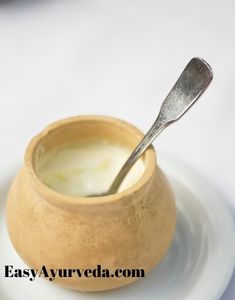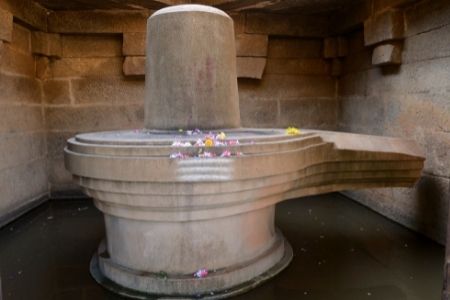Panchamrutham (Panchamrit): Spiritual Significance, Medicinal Uses
Panchamrit is a sacred Ayurvedic combination of cow milk, ghee, curd, honey and sugar. It is used both for spiritual purposes and Ayurvedic medicinal use.

Table of Contents
Ingredients
Cow ghee
Curd (yogurt)
Cow milk
Honey
Candy sugar or sugar
The above five ingredients are taken in equal proportions and mixed thoroughly to prepare Panchamritham.
For the sake of convenience, the quantity of milk can be slightly higher.
Analysis of recipe
Excluding honey, the rest four ingredients are nourishing in nature.
While ghee, milk and sugar are considered coolant, honey and sour curd are hot in nature.
Curd, milk and ghee are explained as source of fat from animal sources – Jangama Snehayoni (Charaka Samhita Sutrasthana 11th chapter)
Milk and ghee
These two are commonly used together. They are used as ingredient in many Ayurvedic medicines used for promoting strength and immunity, such as
Ashwagandha ghee – used for the treatment of male and female infertility, to improve strength and immunity,
Guduchi ghee – used for the treatment of fever, to correct immunity.
Snuni Ksheera Ghrita – for ascites treatment (Charaka Chikitsa, 13/140)
Acharya Charaka declares, क्षीरघृताभ्यासो रसायनानां – kṣīraghṛtābhyāso rasāyanānāṃ| (Charaka Sutrasthana 25/40)
Meaning, having the habit of intake of milk and ghee is the best among all rejuvenating, anti aging recipes.
Honey with ghee
Honey and ghee in equal proportions, in very high doses is considered as toxic. It is explained as a wrong food combination. However, the commentator of Ashtanga Hrudayam explains, it is fine to mix honey and ghee with other ingredients and prepare a medicine out of it. When these two are used in equal quantities, with other ingredients, especially for medicinal purposes, the combination of other ingredients renders it no-toxic.
Hence, it is fine to use equal quantities of honey and ghee in this Divya Panchamrit recipe.
Curd with sugar
It is fine to use curd with sugar.
Curd at night is contraindicated as it can cause Pitta aggravation and indigestion. But Acharya Charaka (Charaka Samhita Sutrasthana 7- 61,62) explains that it can be taken along with sugar, green gram etc., at night, as it will nullify the excess Pitta increasing effect of the curd.
Overall, Panchamritham is a useful combination of five important ingredients.
Ayurvedic Reference
गव्यमाज्यं दधि क्षीरं माक्षिकं शर्करान्वितम् |
एकत्र मिलितं ज्ञेयं दिव्यं पञ्चामृतं परम् ||५४||
अजीर्णभूतवातघ्नं ज्ञेयं पञ्चामृतं परम् |५५|
gavyamājyaṃ dadhi kṣīraṃ mākṣikaṃ śarkarānvitam |
ekatra militaṃ jñeyaṃ divyaṃ pañcāmṛtaṃ param ||54||
ajīrṇabhūtavātaghnaṃ jñeyaṃ pañcāmṛtaṃ param |55|- Dhanvantari Nighantu, Mishrakadi Varga
Benefits
gavyam ājyaṃ – cow ghee
dadhi – curd
kṣīraṃ – milk
mākṣikaṃ – honey
śarkara anvitam – along with sugar
ekatra militaṃ – mixed together (in equal proportions)
jñeyaṃ divyaṃ pañcāmṛtaṃ – is known as Divya Panchamrita. Here, Divya refers to the divine and auspicious.
param – It is a great recipe with numerous health benefits.
ajīrṇa – It is useful in the treatment of digestive disorders such as anorexia, weak digestion, dyspepsia
bhūta – It is useful in the treatment of psychiatric disorders, demonic afflictions, microbial infections
vātaghnaṃ – It balances Vata Dosha, useful in bloating, neurological and musculoskeletal disorders associated with emaciation, muscle wasting, weakness and de-nourishment.
jñeyaṃ pañcāmṛtaṃ param – Such a Panchamrut is considered as a sacred and a great recipe.
The textbook Rajanighantu also explains it as Divya Panchamrutha Yoga.
It is used for the treatment of psychiatric disorders, to improve brain power, concentration.
Effect on Tridosha
Milk – Balances Pitta and Vata Doshas
Ghee – Balances Pitta and Vata
Curd – Balances Vata
Candy sugar – Balances Vata and Pitta
Honey – Balances Kapha
The net effect is Tridosha balancing, with
– Maximum balancing effect on Vata Dosha. All 4, except honey balance Vata Dosha
– Moderate balancing effect on Pitta – Ghee, milk and sugar balance them, but sour curd is neutral-slightly Pitta increasing, honey can increase Pitta Dosha by a small extent.
Least balancing effect on Kapha. Except for honey, rest all can increase Kapha Dosha.
This Kapha promoting nature brings in the memory, intelligence-promoting, tissue health, immunity promoting benefits to Panchamritham.
Proportion adjustments:
So, based on your Dosha desires, you can slightly alter the proportions of ingredients.
For more Kapha balancing effect, increase the quantity of honey in the mix.
For more Pitta balancing effect, increase ghee and sugar
For more Vata balancing effect, no need to do anything. If all ingredients are taken equal, it naturally balances Vata dosha, despite minor resistance from honey.
If you add other ingredients to it, such as Tulsi etc., then the Dosha proposition will change.
Use with metals
Panchamritham is used as a co-drink or used for the purification of many metallic ingredients in the Rasashastra branch of Ayurveda.
गव्यक्षीरं दधि घॄतं माक्षिकं चाथ शर्करा।
पञ्चामृतं समाख्यातं रसकर्मप्रसाधकम् ॥ (रसतरंगिणी २:२१)
gavyakṣīraṃ dadhi ghṝtaṃ mākṣikaṃ cātha śarkarā|
pañcāmṛtaṃ samākhyātaṃ rasakarmaprasādhakam || (rasataraṃgiṇī 2:21)
Panchamrita is explained as Rasa Karma Prasadhaka – used in the metallic and mercurial preparations.
For example, it is used in
Converting calx of copper – Tamra Bhasma into a safe and ambrosia-like form.
This process is explained as Tamra Amrutikarana.
As per modern science, copper is a very toxic metal. But no points for modern science for this discovery because ancient Ayurvedic masters knew it already.
Ayurveda Prakasha explains
न विषं विषमित्याहुस्ताम्रं तु विषमुच्यते ॥
na viṣaṃ viṣamityāhustāmraṃ tu viṣamucyate ||
In front of copper, no other poison can be called a poison. Meaning, copper is one of the most poisonous substances.
But copper has immense anti-bacterial and anti-cancerous effects. How to utilize its medicinal values without causing toxicity?
To take out the toxicity of any metal, its purification (Shodhana) and incineration (Marana) is done. For example, iron is subjected to this procedure to prepare Loha Bhasma, used in anemia, weight loss, aphrodisiac therapy etc.
But even after purifying and incinerating copper, still it carries some adverse effects. Hence, it is further processed to make it safer. This process is Amritikarana, where, Panchamritha is used.
अमृतीकरण विधि
सुमृतं ताम्रचूर्णन्तु तदर्धं गन्धकं तथा।
पञ्चामृतेन सम्पेष्य विधानज्ञो भिषग्वरः ॥
शरावसम्पुटे न्यस्य ताम्रं विहितचक्रिकम् ।
त्रिवारं पुटयेदेवं रसतन्त्रविचक्षणः ॥ (र.त.१७/३७-३८)
The incinerated calx of copper – Tamra Bhasma is taken, mixed with half quantity of purified sulphur, mixed with Panchamarita thoroughly and subjected to heat in a closed mud container. This process is repeated three times.
Spiritual significance

नमामि गङ्गाधरमीशमीड्यम् । उमाधवं देववरं नमामि ॥ २०४ ॥
नमाम्य् अजादीशपुरन्दरादि सुरासुरैरर्चितपादपद्मम् । नमामि देवीमुखवादनानाम् ।
ईक्षार्थमक्षित्रितयं य ऐच्छत् ॥ २०५ ॥ पञ्चामृतैर् गन्धसुधूपदीपैर् । विचित्रपुष्पैर्विविधैश्च मन्त्रैः ।
अन्नप्रकारैः सकलोपचारैः । सम्पूजितं सोममहं नमामि ॥ २०६ ॥ Brahma Purana, 123.206.1
As with the above reference, Panchamritha is commonly used for Abhisheka or pouring over the idols of Hindu Gods.
Because Panchamrita has spiritual significance, it is useful in calming the mind, nourishing the brain and useful to thwart off evil forces, demons, it is offered to the Gods and then consumed.
Scientific explanation:
The beauty of Hinduism is, it has always supported scientific ideas.
Most of the Hindu rituals do have a scientific angle.
The God idols are usually made of
Mud or stone, which contain many metals in minute quantities
Bronze, which is a combination of copper, tin with other components.
5-metal combination, called Panchaloha – Gold, silver, copper, zinc and iron.
So, bathing such an idol with panchamrit makes it rich with micro particles from the metals, which is then orally consumed, thereby, providing the medicinal values of both Panchamrit and the metals in micro quantities to the humans.
Dosage
Usually in Hindu custom, just 1 – 2 teaspoons of Panchamritham is taken everyday. It is not usually consumed in very large doses.
The reason can be, in a very high dose, the toxic combination of honey and ghee can cause indigestion related issues.
Side effects
As this combination is explained as Amrita – nectar, in the said dose, there are no side effects with Panchamrit. However, in a very high dose, it can cause digestive disorders or even Ama – a product of altered digestion and metabolism.
Care should be taken while administering it to people with diabetes, as it contains sugar.
Care should be taken while administering it to people with lactose intolerance.
It is generally considered as safe during pregnancy, lactation period and in children.
However, if you have an allergy to any of the ingredients or having weak digestion strength, it is good to consult your Ayurveda practitioner and take her advice before consuming Panchamrit.
Other references
Apart from the said combination, Several other ingredients are combined and called Panchamrit.
For example,
In Kaiyadeva Nighantu, a broth prepared with horse gram, black gram, flat bean, green gram and pigeon pea is explained as Panchamrita, used for the treatment of fever, digestive, carminative, light to digest, useful in kapha disorders, anorexia, tissue depletion and body ache.
In Raja Nighantu, Guduchi, Gokshura, Musli, Mundi and Shatavari are combined and explained as Panchamrita.
कुलत्थमाषनिष्पावमुद्गाढकिविपाचितः ||७३||
यूषः सर्वज्वरहरो दीपनः पाचनो लघुः |
श्लेष्मघ्नो रुचिकृद्धन्यादङ्गमर्दक्षयाणि च ||७४||
अयं पञ्चामृतो नाम यूषः स्नेहस्य कारणम् |७५| – Kaiyyadeva Nighantu, Kritanna Varga
गुडूची गोक्षुरश्चैव मूषली मुण्डिका तथा |
शतावरीति पञ्चानां योगः पञ्चामृताभिधः ||३०|| – Raja Nighantu, Mishrakadi Varga









